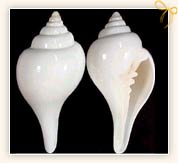
A conch is a sea-dwelling mollusc. In Hindu religion,
it is popularly called as
"Shankha" and considered to be one of
the most auspicious objects that emerged from the sea during the
Ksheera Sagara Samudra Manthan.
Religious Significance
In Indian mythology, the Shankha is regarded sacred and very
auspicious. To initiate religious ceremonies, a shankha (conch shell)
is blown. It is a major Hindu article of prayer.
God Vishnu,
the God of Preservation, is shown with a shankha in one hand and a
disc or a chakra in the other.
Each hindu shankha has a specific name. Vishnu's shankha is called
"Panchajanya". It is believed that when it is blown, it announces
the victory of good over evil. In the epic war,
Mahabharata,
the conch shell held a significant place. Arjuna's shankha was called
"Devdutta",
Bhima's "Paundra",
Yudhisthira's
"Anantavijaya",
Nakula's "Sughosa" and Sahadeva's
was known as "Manipushpaka".
The sacred conch shell is an integral part of Hindu symbolic and
religious tradition. Even today, all Hindus use the conch as a part of
their religious practices. Whenever the conch shell is blown, it is
said to purify the environment from all evil effects.
Scientific significance
Leaving aside the mythology part, the conch shell's significance can
also be corroborated by science. If you try holding a shankha near
your ear, the sound of the gently humming ocean can be heard. This is
actually the natural vibration or cosmic energy of the Earth which
gets magnified on entering the conch shell.
The vibrations from these conch shells can overpower evil forces from
the Earth and at the same time also clear environmental pollution
including healing the hole in the ozone layer which causes global
warming. According to science, the blowing of a conch shell enhances
the positive psychological vibrations such as courage, determination,
hope, optimism, willpower, etc. in the blower as well as those around
him.
There are different
varieties of shankhas depending on size, color and also religious
significance.
Classification by Caste
Brahmana-variety : These shankhas are white in colour, smooth
in texture and light.
Kshatriya-variety : These shankhas are red-coloured or
brown-hued, heavy, rough and course.
Vaishya-variety : These shankhas are yellowish in hue, glossy,
thick and light.
Shudra-variety : The shankhas of this variety are dull gray or
dark brown in color, hard and heavy.
Classification by Religion
There are 6 types of auspicious Shankhas or conch shells known as
"Shad Shubha Shankhas". These are as folllows :
Moti/Pearl Shankhas
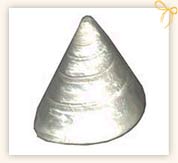
These shankhas shine like a pearl, very rare and
difficult to find. These shankhas have the luster of a pearl and is
generally round in shape. This is a precious variety of shankha and
available in all big and small sizes. Keeping this shankha in house
is considered to be very auspicious and it gives peace of mind. This
kind of shankha is very rare in the sense that studies have shown
that 1 in 15,000 conchs or shankhas will produce a pearl shankha but
only 1/10th of those will be a good pearl conch. Whether a man blows
any conch either small or big, it makes no difference. The influence
of the conch or shankha never lessens. Everyone is aware of the fact
that the right handed conch gives wealth and prosperity. It is to be
noted that the shankha serves its worshipper for progressing
financially but it does not fulfill any human passion.
Dakshinavarti Shankhas
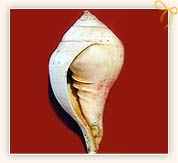
The shankhas that open towards the right hand are
called
Dakshinavarti Shankhas. These shahkhas are rare and
are available in white color with brown lines on them that run
towards the right or South. Lord Kuber (God of wealth) resides in
South and so this shankha represents wealth and prosperity. The
sizes differ and can be from the size of a wheat grain to as large
as a coconut. Dakshinavarti type of shankhas come from deep seas and
are very rare.
Dakshinavarti shankha is considered very auspicious when kept
at any sacred place or the place of worship or the locker in the
house. It should be kept after being wrapped in a white cloth. This
shankha is said to bring good luck and prosperity to the individual
and his family.
Significance of Dakshinavarti Shankha
This Shankha is the symbol of
Goddess Lakshmi. It is said
that she removes sorrows and gives intelligence, success, and
worldly freedom. Traditionally, a Dakshinavarti shankha is similar
in its piousness from the earthly incarnation of Vishnu or Lakshmi
themselves and the blessings of Lakshmi literally flow out of the
remaining shell on their own. Dakshinavarti shankhas not only bring
wealth but also purify the atmosphere. All the negatives energies
are swept out of the place.
Vaamavarti Shankhas
The shankhas that open towards left hand are
Vaamavarti Shankhas. These are the most commonly available shankhas
and used for all religious purposes. In fact, most of the conches
are Vaamvarti, that is, their bulge opens towards left side (facing
North).
The special geometry of a natural shankha creates a positive energy
field and so they are used as Yantras. Some astrologers also
recommend the types of shankha and the location where these are to
be placed to control negative planetary effects. Different methods
of worshipping the shankhas are also described in the Indian
scriptures for benefits varying from wealth, success and peace of
mind to health, healing and hypnotism.
The blowing of a Vaamavarti shankha removes the ill effects of
negative energies and it purifies our surroundings and soul.
Ganesha Shankhas
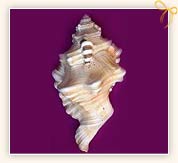
Ganesha shankha is another precious and largely
worshiped shankha. This shankha represents Lord Ganesha and is
worshipped to remove obstacles, for learning, for success, for luck
and prosperity to family. This shankha is considered a very
auspicious item for protection from evil effects and is to get good
luck and prosperity to family.
Ganesha shankha is best when kept in the
Pooja Ghar (place of
worship) daily or on all auspicious occasions and during religious
festivals. It can also be kept in the locker of the house so that
the family never faces any dearth of money. However it should be
kept on red cloth in the worship room or wrapped in red cloth if
kept in a locker.
Significance of Ganesh Shankhas
Ganesha is revered as the son of Lord Shiva and Goddess
Parvati. Ganesha is the first to be worshipped and invoked in Vedic
worship rituals. He is always worshipped for
siddhi (absolute
success in undertakings), and
buddhi (intelligence). He is
considered to be the deity of education, knowledge, wisdom and
literature.
Ganesha shankha is a very rare item and hence considered very lucky.
Every house should have Ganesha Shankha to protect it from evil
effects, to get wealth and prosperity. It is said that Ganesha
Shankha increases the strength of character, mind, enhances
confidence and helps in achieving happiness, fame and good health.
If Ganesha Shankha is used in daily worship, there can be no doubt
that the worshipper of this conch shell is blessed with healthy and
long life of nobility, wisdom, scholarship, entrepreneurship,
foresight and resourcefulness. From Feng Shui's point of view, this
conch attracts business luck from overseas and augments the chances
of travelling abroad
Gaumukhi Shankhas
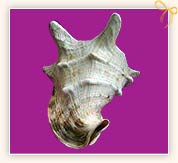
In Hindu Religion, the cow is considered the most
sacred animal. She is a symbol of abundance, of the sanctity of all
lives on Earth. Most Hindus worship and respect the cow as a
matriarchal figure for her gentle qualities and for providing milk.
In Hindu mythology, shankha or conch occupies a very important
place. Shankhas are available in various shapes and sizes. A shankha
which is very popular among the Hindus is the shankha resembling the
cow and hence called as
Gaumukhi Shankha. This shankha
representing the cow's face is considered very sacred. It is said
that if you keep this shankha in a temple or pooja room, it can give
you all the benefits of keeping a cow. This shankha helps in
bringing peace, harmony and happiness to anyone who uses it in his
daily prayers.
Kauri Shankhas
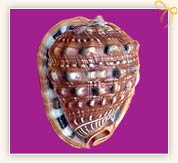
Kauri Shankha is a very rare shankha which when
kept in your house can bring all luck and prosperity.
Significance of Kauri Shankha
It is said since ancient times that the possession of Kauris is
considered to bring wealth and all round prosperity. That is the
reason why it was a part of the marriage attire of the brides. Kauri
is a rare sacred product found in the ocean. As per Hindu mythology,
"Kauri" was obtained from "Samudra Manthan" along with "Lakshmi" and
other rare divine and holy products. From a very ancient time
"Kauri" was used as the currency and then was used in the ornaments
and also used as the key of gambling. As per Hindu Shastras, "Kauri"
is said to be the loving product of "Maha Lakshmi". It is also
related to Lord Shiva because the hairs of Lord Shiva are similar to
"Kauri". Indians also use "Kauri" to decorate Nandi, the devotee of
Lord Shiva. It is also said to be a great tool to save the children
from devil effects. Kauri Shankha is more powerful than kauris
because it is a shankha plus a Kauri. This shankha is usually kept
in the cash box for financial prosperity and to protect the owner
from a financial debacles. Whoever keeps a "Kauri Shankha" during
the prayer of "Goddess Lakshmi", gets blessings and gains success,
prosperity, wealth and fame in life.
 A conch is a sea-dwelling mollusc. In Hindu religion,
it is popularly called as "Shankha" and considered to be one of
the most auspicious objects that emerged from the sea during the
Ksheera Sagara Samudra Manthan.
A conch is a sea-dwelling mollusc. In Hindu religion,
it is popularly called as "Shankha" and considered to be one of
the most auspicious objects that emerged from the sea during the
Ksheera Sagara Samudra Manthan.
 These shankhas shine like a pearl, very rare and
difficult to find. These shankhas have the luster of a pearl and is
generally round in shape. This is a precious variety of shankha and
available in all big and small sizes. Keeping this shankha in house
is considered to be very auspicious and it gives peace of mind. This
kind of shankha is very rare in the sense that studies have shown
that 1 in 15,000 conchs or shankhas will produce a pearl shankha but
only 1/10th of those will be a good pearl conch. Whether a man blows
any conch either small or big, it makes no difference. The influence
of the conch or shankha never lessens. Everyone is aware of the fact
that the right handed conch gives wealth and prosperity. It is to be
noted that the shankha serves its worshipper for progressing
financially but it does not fulfill any human passion.
These shankhas shine like a pearl, very rare and
difficult to find. These shankhas have the luster of a pearl and is
generally round in shape. This is a precious variety of shankha and
available in all big and small sizes. Keeping this shankha in house
is considered to be very auspicious and it gives peace of mind. This
kind of shankha is very rare in the sense that studies have shown
that 1 in 15,000 conchs or shankhas will produce a pearl shankha but
only 1/10th of those will be a good pearl conch. Whether a man blows
any conch either small or big, it makes no difference. The influence
of the conch or shankha never lessens. Everyone is aware of the fact
that the right handed conch gives wealth and prosperity. It is to be
noted that the shankha serves its worshipper for progressing
financially but it does not fulfill any human passion.
 The shankhas that open towards the right hand are
called Dakshinavarti Shankhas. These shahkhas are rare and
are available in white color with brown lines on them that run
towards the right or South. Lord Kuber (God of wealth) resides in
South and so this shankha represents wealth and prosperity. The
sizes differ and can be from the size of a wheat grain to as large
as a coconut. Dakshinavarti type of shankhas come from deep seas and
are very rare.
The shankhas that open towards the right hand are
called Dakshinavarti Shankhas. These shahkhas are rare and
are available in white color with brown lines on them that run
towards the right or South. Lord Kuber (God of wealth) resides in
South and so this shankha represents wealth and prosperity. The
sizes differ and can be from the size of a wheat grain to as large
as a coconut. Dakshinavarti type of shankhas come from deep seas and
are very rare. Ganesha shankha is another precious and largely
worshiped shankha. This shankha represents Lord Ganesha and is
worshipped to remove obstacles, for learning, for success, for luck
and prosperity to family. This shankha is considered a very
auspicious item for protection from evil effects and is to get good
luck and prosperity to family.
Ganesha shankha is another precious and largely
worshiped shankha. This shankha represents Lord Ganesha and is
worshipped to remove obstacles, for learning, for success, for luck
and prosperity to family. This shankha is considered a very
auspicious item for protection from evil effects and is to get good
luck and prosperity to family. In Hindu Religion, the cow is considered the most
sacred animal. She is a symbol of abundance, of the sanctity of all
lives on Earth. Most Hindus worship and respect the cow as a
matriarchal figure for her gentle qualities and for providing milk.
In Hindu mythology, shankha or conch occupies a very important
place. Shankhas are available in various shapes and sizes. A shankha
which is very popular among the Hindus is the shankha resembling the
cow and hence called as Gaumukhi Shankha. This shankha
representing the cow's face is considered very sacred. It is said
that if you keep this shankha in a temple or pooja room, it can give
you all the benefits of keeping a cow. This shankha helps in
bringing peace, harmony and happiness to anyone who uses it in his
daily prayers.
In Hindu Religion, the cow is considered the most
sacred animal. She is a symbol of abundance, of the sanctity of all
lives on Earth. Most Hindus worship and respect the cow as a
matriarchal figure for her gentle qualities and for providing milk.
In Hindu mythology, shankha or conch occupies a very important
place. Shankhas are available in various shapes and sizes. A shankha
which is very popular among the Hindus is the shankha resembling the
cow and hence called as Gaumukhi Shankha. This shankha
representing the cow's face is considered very sacred. It is said
that if you keep this shankha in a temple or pooja room, it can give
you all the benefits of keeping a cow. This shankha helps in
bringing peace, harmony and happiness to anyone who uses it in his
daily prayers.
 Kauri Shankha is a very rare shankha which when
kept in your house can bring all luck and prosperity.
Kauri Shankha is a very rare shankha which when
kept in your house can bring all luck and prosperity.